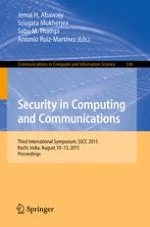2015 | OriginalPaper | Chapter
Anomaly Detection Through Comparison of Heterogeneous Machine Learning Classifiers vs KPCA
Authors : Goverdhan Reddy Jidiga, P. Sammulal
Published in: Security in Computing and Communications
Publisher: Springer International Publishing
Activate our intelligent search to find suitable subject content or patents.
Select sections of text to find matching patents with Artificial Intelligence. powered by
Select sections of text to find additional relevant content using AI-assisted search. powered by
